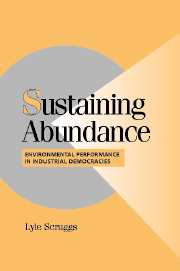Book contents
- Frontmatter
- Contents
- List of Figures and Tables
- Preface
- 1 INTRODUCTION
- 2 MEASURING NATIONAL ENVIRONMENTAL PERFORMANCE
- 3 ECONOMIC DEVELOPMENT, GEOGRAPHIC ADVANTAGE, AND ENVIRONMENTAL PERFORMANCE
- 4 PUBLIC OPINION, ENVIRONMENTAL MOBILIZATION, AND ENVIRONMENTAL PERFORMANCE
- 5 PLURALISM, CORPORATISM, AND ENVIRONMENTAL PERFORMANCE
- 6 POLITICAL INSTITUTIONS
- 7 CHECKING THE ROBUSTNESS OF THE RESULTS
- 8 CONCLUSION
- Appendix I Estimated Measures of Environmental Performance
- Appendix II Institutions for Environmental Policy Making in Fourteen Countries
- References
- Index
- Titles in the series
2 - MEASURING NATIONAL ENVIRONMENTAL PERFORMANCE
Published online by Cambridge University Press: 07 December 2009
- Frontmatter
- Contents
- List of Figures and Tables
- Preface
- 1 INTRODUCTION
- 2 MEASURING NATIONAL ENVIRONMENTAL PERFORMANCE
- 3 ECONOMIC DEVELOPMENT, GEOGRAPHIC ADVANTAGE, AND ENVIRONMENTAL PERFORMANCE
- 4 PUBLIC OPINION, ENVIRONMENTAL MOBILIZATION, AND ENVIRONMENTAL PERFORMANCE
- 5 PLURALISM, CORPORATISM, AND ENVIRONMENTAL PERFORMANCE
- 6 POLITICAL INSTITUTIONS
- 7 CHECKING THE ROBUSTNESS OF THE RESULTS
- 8 CONCLUSION
- Appendix I Estimated Measures of Environmental Performance
- Appendix II Institutions for Environmental Policy Making in Fourteen Countries
- References
- Index
- Titles in the series
Summary
Historically, a major reason that previous work did not directly investigate environmental outcomes was the lack of data with which to make comparisons (Hoberg 1986; Strom and Swindell 1993; Vogel 1986). The statistical abstracts of most national governments have only recently included environmental data alongside the economic, social, and political data collected for decades. In a few countries, the amount of environmentaldata is impressive but often of rather limited duration and not comparable across countries. Evidence from a few countries over short periods may be useful for various purposes but does not permit the evaluation of existing explanations for long-term environmental outcomes within countries. The reason is that short-term fluctuations in economic, social, or environmental conditions may mask long-term trends of man-made environmental impacts. Still, the paucity of empirical studies of outcomes is puzzling, given the stakes involved. For instance, even in the United States the first major empirical work on political determinants of environmental outcomes was not published until the 1990s (Ringquist 1993).
The environmental data in this study come primarily from the OECD's Environmental Data Compendium. It represents the best source from which to ascertain general trends within and across countries in the OECD. This volume has been published biannually since 1985. The data are collected on the basis of a questionnaire coadministered with Eurostat and sent to the member states of the OECD. The compendium provides data on a variety of pollution issues common to OECD countries.
- Type
- Chapter
- Information
- Sustaining AbundanceEnvironmental Performance in Industrial Democracies, pp. 19 - 54Publisher: Cambridge University PressPrint publication year: 2003

